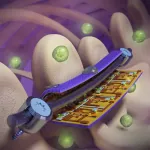(Press-News.org) Should healthy people be screened to help reduce their risk of fragility fractures? A new interactive online Fragility Fracture Decision Aid for shared decision-making can help clinicians and patients visualize their individual risk of fracture and the potential benefits and harms of preventive treatment.
The decision aid is part of a new guideline https://www.cmaj.ca/lookup/doi/10.1503/cmaj.221219 from the Canadian Task Force on Preventive Health Care on screening to prevent fragility fractures. The guideline, published in CMAJ (Canadian Medical Association Journal), recommends a "risk assessment–first" screening process for women 65 years and older, centred around shared decision-making with their primary care providers regarding testing and preventive treatment.
What are fragility fractures?
Fragility fractures are bone breaks at the hip, spine, wrist and other areas; these usually occur after a fall, due to underlying weakened bone structure, and they would not normally cause a break if bones were sufficiently strong. Fractures can lead to chronic pain, disability, hospitalization, a need for long-term institutional care and earlier death.
"Fragility fractures can severely affect quality of life for older adults," said Dr. Guylène Thériault, chair of the Task Force Fragility Fractures Working Group. "For women over age 65, there is good evidence that screening and preventive treatment may reduce fragility fractures. Surprisingly, screening occurs in younger women and men, although there is no evidence of benefit."
Key recommendations of the guideline
Females aged 65 years and older may be able to avoid fracture with screening and preventive medication
Screening is not recommended for females younger than 65 years or males of any age
Clinicians should use a risk assessment–first screening strategy for females 65 years and older:
Use the Fragility Fractures Decision Aid, which uses the Canadian FRAX risk assessment tool to estimate an individual's risk
Help patients consider their risk of fragility fracture and the potential benefits and harms of treatment
Engage in shared decision-making to help patients decide if they would take prescription medication based on their personal risk level
If the patient is considering prescription medication, clinicians should:
Request a bone mineral density (BMD) test
Re-estimate fracture risk by adding the T-score into FRAX to decide on treatment
Patients can use the online Fragility Fracture Decision Aid to calculate their individual risk level; if the risk of fracture is low, then the benefit of treatment is also low. The decision aid can help inform the patient–clinician conversation, as it calculates the potential effect of medication and describes the potential harms.
"Patients should ask for their actual risk and talk to their primary care provider," said Dr. Roland Grad, a coauthor of the guideline. "Not everyone gets the same benefit from preventive medication. In fact, there's no good evidence to support screening men to prevent fragility fractures."
"Prescription medications can help prevent fragility fractures, and these should be taken for about 5 years," said Dr. Grad. "This means the best time to take them is at an age when fracture risk is higher. Even then, shared decision-making between a patient and their clinician is important."
Notably, the guideline is for community-dwelling adults aged 40 years and older. It does not apply to people already taking prescription medication to prevent fragility fractures.
The task force engaged patients and reviewed evidence to understand patient values and preferences. Women aged 50–65 years were interested in screening; however, a high percentage, after having been informed of their individual risk, said they would not choose to be treated with medication.
This new guideline is designed to help physicians and is based on the latest evidence.
"We hope a risk assessment–first approach will help reduce unnecessary BMD tests both for patients and the health care system," said Dr. Donna Reynolds, a family physician and task force member. "It doesn't make sense to order tests that will not lead to treatment decisions."
"This is surprising," said Marie-France, a patient in her 50s living in Quebec who has had many BMD tests. "This new information will surely help family physicians and patients have meaningful discussions and forgo unnecessary tests. Why do a test if your risk is low and you're not interested in taking preventive medication?"
Treatment and prevention without prescribed medication (e.g., vitamin D, calcium, falls prevention and exercise), was beyond the scope of the task force guideline. Guidelines on falls prevention and related topics are planned.
The College of Family Physicians of Canada (CFPC) has endorsed the guideline.
Get the guideline, infographic and related tools here:
Guideline: https://www.cmaj.ca/lookup/doi/10.1503/cmaj.221219
Fragility Fractures Clinician Infographic: https://canadiantaskforce.ca/tools-resources/fragility-fractures-clinician-infographic/
Fragility Fractures Interactive Decision Aid link: https://frax.canadiantaskforce.ca
END
New decision aid to help with screening to prevent fragility fractures
Canadian Task Force on Preventive Health Care issues new guideline
2023-05-08
ELSE PRESS RELEASES FROM THIS DATE:
Pediatric IBD risk linked to antibiotics, Western diet and higher family income
2023-05-07
CHICAGO (May 7, 2023) — Children and adolescents face greater risk of inflammatory bowel disease (IBD) when exposed to antibiotics or a Western diet at early ages, or when their family has higher socioeconomic status, according to a study being presented today at Digestive Disease Week® (DDW) 2023.
“Pediatric IBD cases are rising globally, and approximately 1 in 4 of all IBD cases are now diagnosed before age 21,” said Nisha Thacker, the study’s lead author and a gastrointestinal dietitian. A unique concern about pediatric IBD is the impact that the inflammation has on a child’s growth and the progression of puberty, ...
Domestic abuse exposure linked to increased levels of asthma and other atopic diseases
2023-05-06
Women who have suffered domestic abuse may have a higher risk of developing atopic diseases including asthma, new research has found.
Published today in the Journal of Allergy and Clinical Immunology: In Practice, the research led by the University of Birmingham found that in analysis of patient records, there were a significantly larger percentage of women who had atopic diseases and had a history of being exposed to domestic abuse and violence compared to those who hadn’t.
Dr Joht Singh Chandan from the University of Birmingham and corresponding author of the study said:
“After adjusting for possible cofounders, ...
NIH study identifies features of Long COVID neurological symptoms
2023-05-06
What:
Twelve people with persistent neurological symptoms after SARS-CoV-2 infection were intensely studied at the National Institutes of Health (NIH) and were found to have differences in their immune cell profiles and autonomic dysfunction. These data inform future studies to help explain persistent neurological symptoms in Long COVID. The findings, published in Neurology: Neuroimmunology & Neuroinflammation, may lead to better diagnoses and new treatments.
People with post-acute sequelae of COVID-19 (PASC), which includes Long COVID, have a wide range of symptoms, including fatigue, ...
How interleukin-6 helps prevent allergic asthma and atopy by suppressing interleukin-2 signaling
2023-05-06
BIRMINGHAM, Ala. – The immune system has a biological telecommunications system — small proteins known as interleukins that send signals among the leukocyte white blood cells to control their defense against infections or nascent cancer. Interleukin-6, or IL-6, is one of these key mediators of inflammation, and it can, as needed, provoke the immune system into attack against pathogens.
However, imbalances of IL-6 — too much or too little — can cause disease, even in the absence of infection. Excess IL-6 is central to the pathogenesis of inflammatory reactions like ...
Why are there so few insects in the ocean?
2023-05-06
Tokyo, Japan – Scientists from Tokyo Metropolitan University have proposed a hypothesis for why insects are so rare in marine environments. They previously showed that insects evolved a unique chemical mechanism to harden their shells which uses molecular oxygen and an enzyme called multicopper oxidase-2 (MCO2). Now, they argue that this gives them a disadvantage in the sea, while it confers advantages that help them on land, placing MCO2 at the heart of insect eco-evolution.
Insects are some of the most successful organisms on the planet. ...
Smart surgical implant coatings provide early failure warning while preventing infection
2023-05-05
CHAMPAIGN, Ill. — Newly developed “smart” coatings for surgical orthopedic implants can monitor strain on the devices to provide early warning of implant failures while killing infection-causing bacteria, University of Illinois Urbana-Champaign researchers report. The coatings integrate flexible sensors with a nanostructured antibacterial surface inspired by the wings of dragonflies and cicadas.
In a new study in the journal Science Advances, a multidisciplinary team of researchers found the coatings prevented infection in live mice and mapped strain in commercial implants applied to sheep spines to warn of various implant or healing failures.
“This ...
Artificial intelligence identifies anti-aging drug candidates targeting ‘zombie’ cells
2023-05-05
SAN CARLOS, California – A new publication in the May issue of Nature Aging by researchers from Integrated Biosciences, a biotechnology company combining synthetic biology and machine learning to target aging, demonstrates the power of artificial intelligence (AI) to discover novel senolytic compounds, a class of small molecules under intense study for their ability to suppress age-related processes such as fibrosis, inflammation and cancer. The paper, “Discovering small-molecule senolytics with deep neural networks,” authored in collaboration with ...
How to make the faculty job search less discouraging
2023-05-05
Finding a full-time faculty job can be a daunting challenge for doctoral graduates.
University of Cincinnati anthropologist Kathleen Grogan says postdoctoral researchers can benefit from having peers review their applications.
She learned this herself while working as a postdoctoral researcher. She realized that she and other postdocs routinely solicited feedback in an online messaging app dedicated to aspiring scientists.
“I was on the job market and wanted people with broad scientific expertise to look at my stuff,” said Grogan, an assistant professor in UC’s College ...
Markey Cancer Center earns National Pancreas Foundation Center designation for treatment of pancreatic cancer
2023-05-05
LEXINGTON, Ky. (May 5, 2023) — The University of Kentucky Markey Cancer Center has been recognized by the National Pancreas Foundation (NPF) as an approved NPF Center of Excellence.
The designation is awarded after a rigorous audit review to determine that an institution's focus is on multidisciplinary treatment of pancreatic cancer, treating the “whole patient” with a focus on the best possible outcomes and an improved quality of life.
“We are honored to receive the NPF designation, which highlight’s Markey’s commitment to multidisciplinary ...
Scientists capture elusive chemical reaction using enhanced X-ray method
2023-05-05
Researchers at SLAC National Accelerator Laboratory captured one of the fastest movements of a molecule called ferricyanide for the first time by combining two ultrafast X-ray spectroscopy techniques. They think their approach could help map more complex chemical reactions like oxygen transportation in blood cells or hydrogen production using artificial photosynthesis.
The research team from SLAC, Stanford and other institutions started with what is now a fairly standard technique: They zapped a mixture of ferricyanide and water with an ultraviolet laser and bright X-rays generated by the Linac Coherent Light Source (LCLS) X-ray free-electron laser. ...
LAST 30 PRESS RELEASES:
Statins significantly reduce mortality risk for adults with diabetes, regardless of cardiovascular risk
Brain immune cells may drive more damage in females than males with Alzheimer’s
Evidence-based recommendations empower clinicians to manage epilepsy in pregnancy
Fungus turns bark beetles’ defenses against them
There are new antivirals being tested for herpesviruses. Scientists now know how they work
CDI scientist, colleagues author review of global burden of fungus Candida auris
How does stroke influence speech comprehension?
B cells transiently unlock their plasticity, risking lymphoma development
Advanced AI dodel predicts spoken language outcomes in deaf children after cochlear implants
Multimodal imaging-based cerebral blood flow prediction model development in simulated microgravity
Accelerated streaming subgraph matching framework is faster, more robust, and scalable
Gestational diabetes rose every year in the US since 2016
OHSU researchers find breast cancer drug boosts leukemia treatment
Fear and medical misinformation regarding risk of progression or recurrence among patients with breast cancer
Glucagonlike peptide-1 receptor agonists and asthma risk in adolescents with obesity
Reviving dormant immunity: Millimeter waves reprogram the immunosuppressive microenvironment to potentiate immunotherapy without obvious side effects
Safety decision-making for autonomous vehicles integrating passenger physiological states by fNIRS
Fires could emit more air pollution than previously estimated
A new way to map how cells choose their fate
Numbers in our sights affect how we perceive space
SIMJ announces global collaborative book project in commemoration of its 75th anniversary
Air pollution exposure and birth weight
Obstructive sleep apnea risk and mental health conditions among older adults
How talking slows eye movements behind the wheel
The Ceramic Society of Japan’s Oxoate Ceramics Research Association launches new international book project
Heart-brain connection: international study reveals the role of the vagus nerve in keeping the heart young
Researchers identify Rb1 as a predictive biomarker for a new therapeutic strategy in some breast cancers
Survey reveals ethical gaps slowing AI adoption in pediatric surgery
Stimulant ADHD medications work differently than thought
AI overestimates how smart people are, according to HSE economists
[Press-News.org] New decision aid to help with screening to prevent fragility fracturesCanadian Task Force on Preventive Health Care issues new guideline





